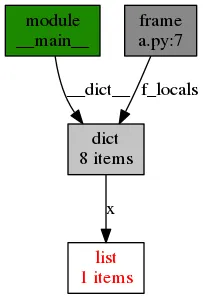我通常在www.codefights.com上作为竞争者编写代码(函数)。所以速度是代码的重要部分之一。如何测量Python语言中某个代码的速度,无论是lambda函数还是def函数。
5个回答
21
3步完成 ;)
第1步: 安装 line_profiler
pip install line_profiler
步骤2:在您的代码中添加@profile:
from time import sleep
@profile
def so_slow(bar):
sleep(5)
return bar
if __name__ == "__main__":
so_slow(5)
步骤 3:测试您的代码:
kernprof -l -v your_code.py
结果
Wrote profile results to your_code.py.lprof
Timer unit: 1e-06 s
Total time: 5.00283 s
File: your_code.py
Function: so_slow at line 4
Line # Hits Time Per Hit % Time Line Contents
==============================================================
4 @profile
5 def so_slow(bar):
6 1 5002830 5002830.0 100.0 sleep(5)
7 1 2 2.0 0.0 return bar
memory_profiler(内存分析工具)
你也可以使用memory_profiler,安装它,添加分析并调用它:
pip install memory_profiler
python -m memory_profiler your_code.py
结果:
Filename: your_code.py
Line # Mem usage Increment Line Contents
================================================
4 21.289 MiB 0.000 MiB @profile
5 def so_slow(bar):
6 21.289 MiB 0.000 MiB sleep(5)
7 21.289 MiB 0.000 MiB return bar
更新:
您可以使用objgraph来查找内存泄漏或绘制代码的图形:
from time import sleep
import objgraph
x = [1]
objgraph.show_backrefs([x], filename='sample-backref-graph.png')
def so_slow(bar):
sleep(5)
return bar
if __name__ == "__main__":
so_slow(5)
结果:
参考资料: Python性能分析指南
- RaminNietzsche
1
1你知道如何去除“行内容”吗?我正在尝试读取一个有很多行文本的PDF文件,我不想让它们混杂在我的控制台中。我只需要整个脚本从开始到完成的时间。 - Azurespot
16
请查看Python标准库中的timeit模块:
https://docs.python.org/2/library/timeit.html
>>> import timeit
>>> timeit.timeit('"-".join(str(n) for n in range(100))', number=10000)
0.8187260627746582
>>> timeit.timeit('"-".join([str(n) for n in range(100)])', number=10000)
0.7288308143615723
>>> timeit.timeit('"-".join(map(str, range(100)))', number=10000)
0.5858950614929199
为了让 timeit 模块可以调用您定义的函数,您可以传递一个 setup 参数,其中包含一个 import 语句:
def test():
"""Stupid test function"""
L = []
for i in range(100):
L.append(i)
if __name__ == '__main__':
import timeit
print(timeit.timeit("test()", setup="from __main__ import test"))
- Mandraenke
15
例如:
import timeit
def a():
return 1+1
print timeit.timeit(a, number=1000000)
- Alexander Ejbekov
2
您可以在IPython中使用它,并使用%time查看执行函数所需的分配时间:
In [1]: def function(a,b):
...: return a+b
...:
In [2]: %time function(1, 2)
CPU times: user 5 µs, sys: 0 ns, total: 5 µs
Wall time: 9.06 µs
Out[2]: 3
- Chris PERE
2
我通常在需要测量某些非常特定的代码片段的执行时间时,依赖于以下内容:
https://docs.python.org/3/library/time.html
def howLong():
startTime = time.time()
time.sleep(3)
print("Time to wake up, ~3 seconds have passed!")
endTime = time.time()
howMuchTime = endTime - startTime
print(str(howMuchTime) + " sec")
if __name__ == '__main__':
import time
howLong()
结果
Time to wake up, ~3 seconds have passed!
3.013692855834961 sec
- Tomaso Forchiassin
网页内容由stack overflow 提供, 点击上面的可以查看英文原文,
原文链接
原文链接

timeit模块。或者使用time模块创建自定义计时装饰器。 - Christian Deanstart = time.process_time()(或time.time())获取当前时间,然后在调用之后再次获取当前时间,这样所花费的时间就是差值time.process_time() - start。 - ForceBru